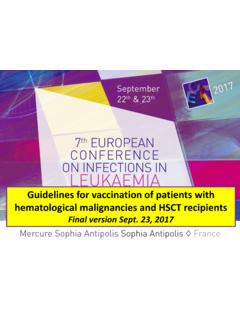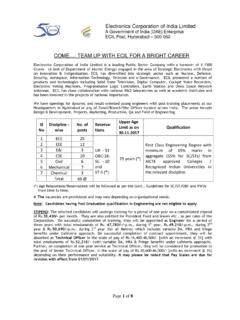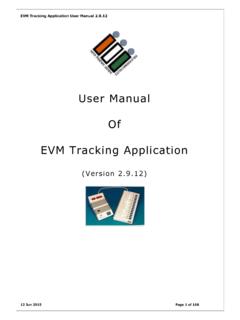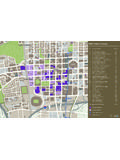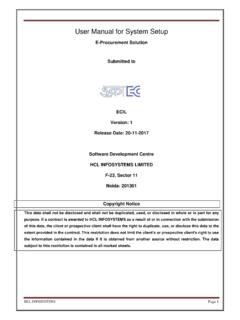Transcription of ECIL guidelines for the prevention, diagnosis and ...
1 ECIL guidelines for the prevention, diagnosis and treatment of BKpolyomavirus-associated haemorrhagic cystitis in haematopoieticstem cell transplant recipientsSimone Cesaro1* , Tina Dalianis2, Christine Hanssen Rinaldo3,4, Minna Koskenvuo5, Anna Pegoraro1,Hermann Einsele6, Catherine Cordonnier7and Hans H. Hirsch8,9 on behalf of the 6th European Conference onInfections in Leukaemia (ECIL-6) , a joint venture of the Infectious Diseases Working Party of the EuropeanGroup for Blood and Marrow Transplantation (EBMT-IDWP), the Infectious Diseases Group of the EuropeanOrganization for Research and Treatment of Cancer (EORTC-IDG), the International Immunocompromised HostSociety (ICHS), and the European Leukaemia Net (ELN)1 Pediatric Hematology-Oncology, Azienda Ospedaliera Universitaria Integrata Verona, Italy;2 Department of Oncology Pathology,Karolinska Institutet, Stockholm, Sweden;3 Department of Microbiology and Infection Control, University Hospital of North Norway,Troms , Norway;4 Metabolic and Renal Research Group, UiT The Arctic University of Norway, Troms , Norway;5 Division ofHematology-Oncology and Stem Cell Transplantation, Children s Hospital, Helsinki University Central Hospital, University of Helsinki,Finland.
2 6 Department of Internal Medicine II, University Hospital Wu rzburg, Julius Maximilians University Wu rzburg, Germany;7 Assistance Publique-Ho pitaux de Paris, Henri Mondor Teaching Hospital, Department of Hematology, 94000 Cre teil, Paris-Est Cre teil(UPEC) University, Cre teil;8 Transplantation & Clinical Virology, Department Biomedicine (Haus Petersplatz), University of Basel,Petersplatz 10; CH-4009 Basel, Switzerland;9 Infectious Diseases & Hospital Epidemiology, University Hospital Basel, Petersgraben 4,CH-4031 Basel, Switzerland*Corresponding author. Pediatric Hematology Oncology, Azienda Ospedaliera Universitaria Integrata, A. Stefani 1, 37126, Verona, :!39-045-8127874; Fax!39-045-8126326; E-mail: These authors made an equal contribution. ECIL-6 members are listed in the Acknowledgements :To define guidelines for BK polyomavirus (BKPyV)-associated haemorrhagic cystitis (BKPyV-HC) afterpaediatric and adult :Review of English literature and evidence-based recommendations by expert :BKPyV-HC occurs in 8% 25% of paediatric and 7% 54% of adult recipients undergoing allogeneic requires the triad of cystitis, macro-haematuria and high urine BKPyV log10copies/mL, andexclusion of other relevant aetiologies.
3 BKPyV viraemia is frequent and may serve as a more specific semiquanti-tative follow-up marker. No randomized controlled trials are available to inform antiviral prophylaxis or treat-ment. However, hyper-hydration and/or bladder irrigation showed limited prophylactic value. Fluoroquinolonesare not effective for prophylaxis or treatment, but rather increase antibiotic resistance. Hyperbaric oxygen or fi-brin glue is marginally effective based on small case series from correspondingly equipped centres. Althoughcidofovir has been reported to improve and/or reduce BKPyV viraemia or viruria, the current data do not supportits regular :BKPyV-HC remains a disabling unmet clinical need in HSCT that requires novel approaches sup-ported by proper clinical cystitis (HC) is a significant complication after HSCT,the incidence ranging from 2% to 66% according to the type andprocedure of HSCT and the age of the patients. HC contributes topost-HSCT morbidity by prolonging hospital stay and severely wor-sening the quality of life, but its role in increasing post-HSCT mor-tality is 4 Several factors contribute to theappearance of HC, which is also reflected in the classification basedon the time of onset in the post-HSCT course.
4 Early-onset HC isdefined as occurring within,1 week of HSCT, typically during orwithin 48 h of conditioning and is considered to result largely fromdirect toxicity of the conditioning regimen on the urothelial mu-cosa, particularly from drug metabolites and damage is worsened by inflammation leading toVCThe Author 2017. Published by Oxford University Press on behalf of the British Society for Antimicrobial Chemotherapy. All rights Permissions, please email: Antimicrob from UNIV VERONA useron 09 September 2017haemorrhagic leakage aggravated by impaired coagulation HC, on the other hand, usually starts around thetime of neutrophil engraftment, particularly in the setting of allo-geneic HSCT, but can be observed from 2 weeks up to the first6monthspost-HSCT,1,5 10and is mostly associated with high-levelBK polyomavirus (BKPyV) replication. BKPyV is one of 13 knownhuman polyomavirus ,11 The discovery of BKPyV datesback to 1971 when it was isolated from the urine of the kidneytransplant patient , shedding epithelial cells with nuclear viralinclusions, so-called decoy cells.
5 11,12A consistent link of BKPyV todisease was missing until identifying its role in HC after HSCT,6,7and nephropathy after kidney 15We summar-ize the biology, epidemiology and clinical characteristics of BKPyV-HC in haematology patients and provide recommendations thatwere discussed and approved at the 6th meeting of the EuropeanConference on Infectious Disease in Leukaemia (ECIL-6)16held on11 12 September 2015 in Sophia Antipolis, is a joint initiative supported by the European LeukaemiaNetwork, the Infectious Diseases Working Party of the EuropeanAssociation for Blood and Marrow Transplantation (IDWP-EBMT),the Infectious Disease Group of European Organization for Researchand Treatment of Cancer, and the Immunocompromised HostSociety (ICHS). For the 6th edition, the ECIL Board decided to addressBKPyV and endorsed a panel of experts to review the paediatricand adult literature and propose guidelines for affected haemato-logy patients.
6 The panel included two members of the ECIL Board ( , H. E.) and four European experts on BKPyV [T. D., C. H. R., M. K., H. (IDWP-EBMT member and current ICHS president elect)]. TheECIL-6 Consensus Conference wasattended by 55 participants from24 countries (18 European countries, 6 non-European countries).The supporting scientific societiescontributed to the selection ofparticipants by proposing 10 members each, whereas the ECIL board invited the remaining participants based on their scientificand/or clinical expertise in managing infectious complications inhaematology searchThe literature search was performed by S. C. and A. P. using the fol-lowing terms in PubMed: BK polyomavirus, haemorrhagic cystitis,and haematopoietic peripheral stem cell or bone marrow, or cordblood transplantation. Studies published until 31 August 2015 re-garding biology and mechanism of pathogenesis of BKPyV as wellas diagnosis , prophylaxis, and therapy of BKPyV-HC were identified,missing papers were added, and all were reviewed by all panel ex-perts.
7 The results of the literature search and a preliminary draft ofrecommendations for diagnosis , prophylaxis and treatment ofBKPyV-HC were presented to the ECIL-6 conference for discussionand approval. The final recommendations were graded accordingto the ECIL-6 evidence-based medicine grading system, presentedin update of the search was performed on24 January 2017, but was not found to change the current recom-mendations. A schematic representation of the BKPyV virion struc-ture is shown in Figure1and its genome organization is shown inFigureS1(available asSupplementary dataatJACO nline).An overview of BKPyV biology, immune response and diseaseis given in theSupplementary pathogenesis, clinical presentationand diagnosisBKPyV-HC is rare in haematology patients other than thoseundergoing allogeneic HSCT. BKPyV-HC occurs between 2 and8 weeks (range 1 week 6 months) after HSCT, typically starting dur-ing the peri-engraftment period, and should be distinguished froman early-onset HC (,1 week after HSCT) caused by toxicity of theconditioning regimen such as cyclophosphamide and busulfan, ortotal body 21In HSCT patients, high-level equivalents (gEq)/mL is associated with anincreased risk for 24 However, high-level BKPyV viruriais not specific for BKPyV-HC, of all HSCT patients develophigh-level BKPyV viruria, while only 5% 20% develop ,21 High-level BKPyV viruria and BKPyV-HC are mainly observed in allo-geneic HSCT patients receiving full conditioning and an 27 Adenovirus,herpes simplex virus, JC polyomavirus, cytomegalovirus (CMV) andother infectious (bacteria, parasite)
8 And non-infectious aetiologiesTable systems used at ECIL-6 for levels of evidence andstrength of recommendationsGradingCriteriaQuality of evidenceIEvidence from at least 1 properly designed,randomized, controlled trial (oriented atprimary endpoint of the trial).II (r, t, h, u, a)aEvidence from at least 1 well-designed clin-ical trial (including secondary endpoints)without randomization; from cohort orcase control studies (preferably ); from multiple time series; orfrom dramatic results of from opinions of respectedauthorities, based on clinical experience,descriptive case studies or report of ex-pert of recommendationAECIL strongly supports a recommendationfor moderately supports a recommenda-tion for marginally supports a recommenda-tion for supports a recommendation II evidence abbreviations: r, meta-analysis or systematic review ofrandomized controlled trial; t, transferred evidence, results from dif-ferent patient cohorts or similar immune status situation; h, comparatorgroup was historical control; u, uncontrolled trials.
9 A, published abstractpresented at an international symposium or from UNIV VERONA useron 09 September 2017(bleeding disorders with or without low platelet count, primary ormetastatic neoplasia, vesical catheter or ureteric stenting) mayalso cause HC, and must be excluded for appropriate diagnosis ,28 30 The severity of haematuria is commonlydescribed as microscopic (grade 1); macroscopic (grade 2); macro-scopic with clots (grade 3); or macroscopic with clots and post-renal failure secondary to urinary tract obstruction (grade 4).4,21 Thus, the diagnosis of BKPyV-HC requires the triad of: (i) clinicalsymptoms/signs of cystitis, such as dysuria and lower abdominalpain; (ii) a haematuria grade 2 or higher; and (iii) the demonstrationof BKPyV viruria, with viral loads (Table2).Plasma viral loads 4 log10copies/mL are seen in more thantwo-thirds of allogeneic HSCT recipients with BKPyV-HC1,10,31 33and declining plasma loads have been found to correlate withclinical recovery.
10 The pathogenesis of BKPyV-HC is not well under-stood as similarly high urine BKPyV loads are found in kidneytransplant patients, most of whom do not develop cystitis ,35 Rather, a sequence of events has beensuggested, starting with subclinical urothelial damage by the condi-tioning regimen, high-level BKPyV replication leading to viral de-nudation of the pre-damaged, regeneration-impaired urotheliallining and urinary leakage in submucosa followed by haemorrhagicexacerbation with abundant inflammatory cell infiltrates followingallogeneic stem cell ,21,36 Indeed, conditioninginvolving cyclophosphamide, busulfan and total body irradiationhas been implicated in different studies,25,26,29and the pronouncedtoxic, inflammatory properties of cyclophosphamide and its me-tabolite acrolein are supported by clinical and experimental 39 Following the widespread use of hyperhydration, theexposure of the bladder urothelium to toxic metabolites can bereduced, and acute toxicity with early-onset HC has ,21 Nevertheless, subclinical urotoxic exposure may still causedamage with rarefication of the urothelial cell layer, which com-bined with local inflammation stimulates BKPyV replication duringimpaired antiviral immune control from cytotoxic T cells.
